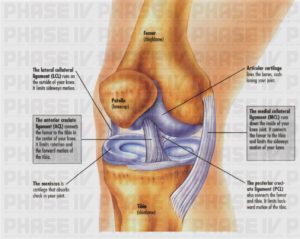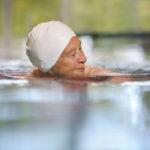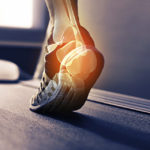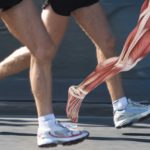LATERAL KNEE PAIN
By Robert Forster, PT
 Pain on the outside of the knee is one of the most common complaints from marathoners we see as they build up the mileage in training. The usual culprit is excessive friction between the thick band of fascia on the outside of the thigh called the Illiotibial band, and the bump at the end of the thighbone (femur). In most cases, the pain is in one knee and not the other. This begs the question: why would only one knee hurt if both legs ran the same mileage? The answer, as in all one sided “asymmetric” marathon overuse injuries, a mechanical deviation in the pelvis on the injured or non injured side of the body.
Most often, the cause of IT band syndrome is a pelvic misalignment, causing a functional leg length discrepancy. When the pelvis is unbalanced, the joints of the “short” or “long” leg will make adjustments to compensate in an attempt to level the pelvis. Typically, the foot on the long leg side will over-pronate as a strategy to flatten the arch and functionally shorten that leg while the foot on the short side will typically supinate in an attempt to hold that arch up and functionally elongate that leg. Either of these subtle but significant compensations will cause aberrant forces to bear down on the vulnerable tissues on the outside of your knee. An effective rehabilitation program must not only treat the painful area, but also address the cause of injury by exposing and correcting the mechanical imbalance at the pelvis.
Pain on the outside of the knee is one of the most common complaints from marathoners we see as they build up the mileage in training. The usual culprit is excessive friction between the thick band of fascia on the outside of the thigh called the Illiotibial band, and the bump at the end of the thighbone (femur). In most cases, the pain is in one knee and not the other. This begs the question: why would only one knee hurt if both legs ran the same mileage? The answer, as in all one sided “asymmetric” marathon overuse injuries, a mechanical deviation in the pelvis on the injured or non injured side of the body.
Most often, the cause of IT band syndrome is a pelvic misalignment, causing a functional leg length discrepancy. When the pelvis is unbalanced, the joints of the “short” or “long” leg will make adjustments to compensate in an attempt to level the pelvis. Typically, the foot on the long leg side will over-pronate as a strategy to flatten the arch and functionally shorten that leg while the foot on the short side will typically supinate in an attempt to hold that arch up and functionally elongate that leg. Either of these subtle but significant compensations will cause aberrant forces to bear down on the vulnerable tissues on the outside of your knee. An effective rehabilitation program must not only treat the painful area, but also address the cause of injury by exposing and correcting the mechanical imbalance at the pelvis.
Anatomy and Function
 The illiotibial band is a thick band of fascia that extends from the pelvis down along the outside of the thigh to attach below the knee on the outside of the lower leg bone called the tibia. The IT Band functions to stabilize the thighbone and knee during the weight bearing “stance” phase of the running or walking gait, and helps guide the lower leg as it swings forward through the air in the swing phase. Just before foot strike, the illiotibial band slides over a bony prominence on the outside of the knee called the lateral epicondyle. This irritates a structure called a bursa (a fluid filled sac much like an internal blister that is supposed to be there) which is designed to prevent friction between the bony prominence and the illiotibial band.
The illiotibial band is a thick band of fascia that extends from the pelvis down along the outside of the thigh to attach below the knee on the outside of the lower leg bone called the tibia. The IT Band functions to stabilize the thighbone and knee during the weight bearing “stance” phase of the running or walking gait, and helps guide the lower leg as it swings forward through the air in the swing phase. Just before foot strike, the illiotibial band slides over a bony prominence on the outside of the knee called the lateral epicondyle. This irritates a structure called a bursa (a fluid filled sac much like an internal blister that is supposed to be there) which is designed to prevent friction between the bony prominence and the illiotibial band.








